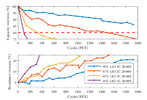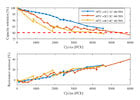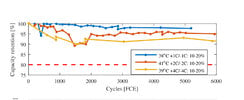Flooring the pedal mess up your battery way more than SOC levels.
Well, it actually does not.
Cyclic aging is very low for the most EV owners, like 0.5% degradation each year from cyclic aging.
If you always went full throttle from 100% to 0%, there would be a significant reduction of capacity.
Higher power increase the cyclic degradation but in general batteries are good at withstanding shorter bursts like 10-15s. This is the same reason as why Teslas can do regen at much higher power at high SOC than they can supercharge.
Most cyclic tests in research is done at 1C, which is approximately = 80kW power in a 3/Y and 100kW in S/X.
This is sufficient for driving at around 200kph/125 mph.
At this rate, we still get ~1000 FCE cycles if we charge to 100 and drive down to 0%.
(1000 FCE equals ~ 400.000 km or 250.000 miles).
Hete we can se high currents on both charge and discharge. Lithium ion batteries dislikes charging at high current/power much much more than discharge at high current/power.
View attachment 1042513
The same cell type, but smaller depth of discharge:
View attachment 1042514
Same, but even smaller depth of discharge:
View attachment 1042515
They still charge with the same C rate, which is mych worse than discharge.
This is a test of Panasonic NCA (NCR18650B) like the S/X
We can see that small cycles at low power (40-60% and C/2 so ~ 40-50kW) is good, but also that there is not a big difference between 20-80% at 1C (80-100kW) and 2C (160-200kW) between 0-100%.
Many tests show that panasonic NCA hold up as good at 2C as at 1C.
View attachment 1042517
Using high power for shorter bursts as a 0-60 pull of a 1/4 mile will not affect the battery that much. Same with driving a illegaly fast drive at 125mph/200kph.
We will most probably not even see a difference in capacity between a slowly driven car and one used like above from time to time.
Accelerating the car to top speed and keeping it there until the battery is drained will probably be noticed as increased degradation if it is done
several times.
Just charging daily to 80-90% and driving average annual ranfes will make the battery loose ~ 10% in calendar aging during the first four years.
It would be very hard to reach a cyclic aging of 10% for the first four years.
My M3P was charged low daily, but > 30 full charges during 2.5 years. I did a lot of 0-60 mph and 1/4 mile runs. (I used the power very often).
Still my car had very low degradation compared to other M3P with the same ODO reading.
Same with my Plaid, I have used the power quite much (which is clearly noticed on the tires threads) but my battery is way above the average Plaid capacity after 1 year from the manufacturing date.
The gain I get from having low SOC most of the time
widely surpasses the small extra losses from the use of high power.
My battery topped 98.4 kWh according to the BMS, and still is at 97.2 kWh after 19K km / 12K mi and one year.
The other Plaids in Sweden I know about using Scan my tesla and about the same climate has lost much more capacity. (The are below 95kWh after one year and sbout the same ODO).
From forum discussions we can se that we have similar addiction for high power and fast acceleration

(The other guys mostly do 80% daily)
Aakee: passing one car increase the temperature of the pack 1°c . That's rough

Your totally wrong. That's why tesla reduced the output after a peak on our packs. And charging etc.
This is what really degrading batterys. That's why other manufacturers have time limits etc. 5sec.. 7 sec. No heat problem. Just what this do to cells.
Teslas battery guru represented Tesla in a Cort in Norway. They didn't realize what kind of damage high currant in / out did to a "cold" batteri(not winter cold)..
the early Panasonic NCA seem to have been more sensitive to cold cycling. Nit very bad but at least they did wear more from cold cycles.
The newer Panasonic NCA does not struggle with this.
Tesla only heats these actively to a few degrees above freezing, like ~ 3.5-4C (valid for both my former M3P 2021 and my current MSP).
During drives my MSP use the heat pump to suck the heat energy out of the pack down to 5C, then it is allowed to warm to ~ 8C before the heat pump draw it down to 5C again.
I live in a cold climate and had a two year logged average of cell temp of 13.5C in my M3P. Much of the 66K km driving has been done with fairly cold pack. Still the degradation was very low, I do not know of a M3P with such low degradation after 2.5 years/66K km.
My MSP is only 1 year and 20K km, so not that long time but I havent heard of another Plaid with such low degradation after 1 year.
My pack is at 97.2 kWh, which is about where many other tops and newer reaches higher.
(> 10 full charges, I do not have the number of supercharges but ~ 15-20 I guess).
If cold was killing the new batteries, Tesla wouldnt let the heatpump suck the heat out of the pack.
He had Lot of good info. It's a reason tesla heating the packs more over time. forget about soc. Don't let it stay 10> <90 over a long period.
Below 10% is not bad for the battery.
100% is not as bad as the rumor. While I do not recommend leaving the car at 100% for long time, 80% is about as bad. See picture above.
Same but actual model S cells
If you love your battery, touch the throttle as little as possible. It's a killer. Always was
But still, having the car above 60% will wear harder on the battery. At least for the panasonic lithium ion cells of today.





